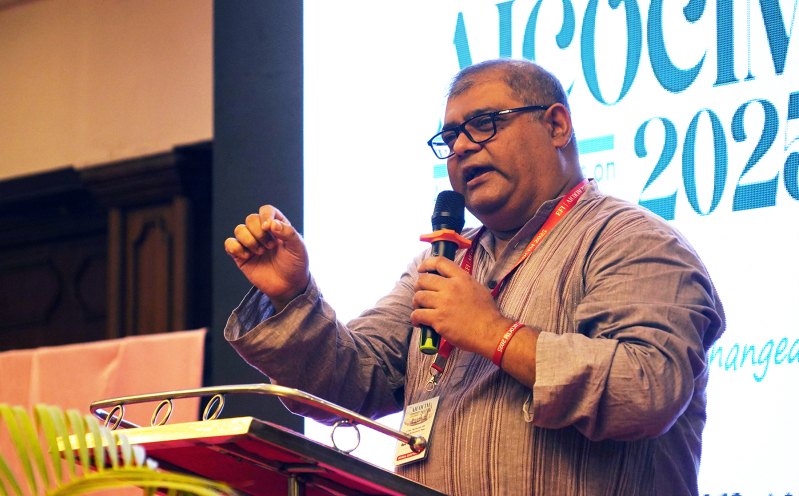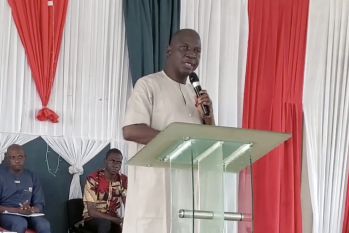
The Church in India is witnessing remarkable growth, a sign of God’s work across the country, said Rev. Vijayesh Lal, General Secretary of the Evangelical Fellowship of India (EFI), in an exclusive interview with Christian Daily International. But he cautioned that alongside the encouraging expansion there is a pressing need for greater depth in discipleship, leadership, and community engagement.
“Conservatively speaking, between 3,000 to 5,000 people come to Christ every day in India,” Lal said, calling the pace of growth “explosive”, even if not quite to the same extent as in Africa.
Yet, he noted that there is still no comprehensive research to measure it accurately. “I wish I had the data to back it up, but we have not done a good job at research,” he said, adding that the numbers are generally based on anecdotal evidence rather than systematic study. “Once we do get accurate research done—and first Indians have to get serious about it—I am convinced the growth rate will prove to be even higher than what is currently estimated by groups like Operation World and others.”
Much of this growth, Lal explained, is taking place in northern and central India, in states such as Uttar Pradesh and Bihar. “There are movements over movements in eastern Uttar Pradesh that are indigenous,” he said. “Not one of them is engaging or even being supported by anybody in the West.”
These are not isolated incidents but grassroots movements in which entire communities are turning to Christ and reorienting their lives around Him.
“The Church has grown in spite of us rather than because of us,” Lal reflected, acknowledging that his comments may sound controversial. “Strategies don’t work, but the Lord is up to something, and we see the footprint of that everywhere.”
Emerging Christward movements among Hindus and Muslims are deeply rooted in Indian culture
Lal said the current wave of conversions is unlike anything India has seen before, marked by entire communities turning to Christ on their own initiative and shaping a distinctly Indian expression of faith. Many believers, he noted, do not adopt denominational labels but simply call themselves followers of Jesus.
“There are at least eight to nine Christward movements that have been identified,” he explained. “They are Christian by conviction and by practice, but they have not turned to organized Christianity as such. Instead, they have turned to the person of Jesus Christ.”
These movements, he said, reflect an extraordinary grassroots vitality. Congregations worship, pray, and live out their faith in ways that are deeply embedded in local culture rather than imported missionary traditions. “They might not be as well versed in doctrine as somebody in the West would like them to be,” Lal observed. “So to judge them, you have to come up with different standards.”
But he stressed the importance of connecting with the movements. “We must engage with them, so they feel comfortable stepping into the mainstream of Christianity,” he said, adding that such engagement is key to ensuring they grow in confidence and unity with the wider Church.
Yet, for Lal, the greatest challenge lies in turning rapid growth into mature discipleship. “They know how to worship the Lord, they know how to pray, and they know some fundamentals of the Bible,” he said. “But doctrinal grounding and leadership development are the biggest needs in the Indian church today.”
Fully committed to Christ, but Indian Church a ‘mixed bag’ in other aspects
Lal described the Indian church as resilient and deeply committed, even in places where hostility or harassment makes Christian life difficult. “Even though they’re persecuted, they won’t go back,” he said. “In terms of commitment to faith, you cannot fault them.”
At the same time, Lal said the picture of the Indian church is a “mixed bag” in other aspects — sociopolitical standing, financial capacity, and spiritual maturity. Congregations in southern and northeastern India are generally better resourced and more established, while emerging churches in the central and northern regions are much poorer and face greater day-to-day challenges.
This economic disparity, he noted, shapes how leadership development and discipleship efforts are implemented. Churches with greater resources are able to provide structured training and mentorship for pastors and lay leaders, whereas poorer congregations still lack access to similar programs. This, he highlighted, is one of the greatest needs.
India’s emerging role as a mission force
Lal said one of the most encouraging developments is the growing realization that India is no longer just a mission field but also a contributor to the global missionary movement. Churches and mission agencies across the country are sending workers to Asia, Africa, and beyond.
“There are a number of denominations that already have missionaries in different parts of the world,” Lal explained. “Southeast Asia, Africa, Central Asia. We are sending missionaries to China.”
Although still modest in size compared to missionary-sending powerhouses such as the United States and South Korea, India’s contribution is quietly increasing. Lal offered a conservative estimate of between 750 and 1,000 Indian missionaries currently serving abroad — not counting those who move to the West as pastors and evangelists.
“The realization is there that we are a Church that has to go from everywhere to everywhere,” Lal said, describing a growing awareness among Indian Christians that they have a responsibility to participate in world evangelization. He noted that churches in the northern and central regions, where growth is most rapid, are not yet sending missionaries in large numbers but will likely do so as they mature and become more organized.
He recalled his own surprise on a recent trip to Mongolia for a meeting organized by the Asia Evangelical Alliance. “I discovered Indian missionaries over there,” he said with a laugh. “Yes, in Mongolia! I had no idea. I asked them, ‘What are you guys doing here?’” For Lal, this is evidence that Indian believers are already stepping into the global mission field, sometimes quietly and without recognition.
“The future is going to be exciting,” he said, expressing confidence that the number of missionaries going out from India will only increase in the years to come.
The real challenge is materialism
Queried about some of the challenges that believers in India face, Lal warned that while persecution can refine and even strengthen faith, a more subtle danger is threatening the Church from within: materialism. “Indian society as a whole has become what the government calls an ‘aspirational class,’” he said, noting that the Church has not been immune to this shift.
“There is a definite pull towards defining success in terms of material success,” Lal explained. This desire for upward mobility, common across modern India, has also seeped into Christian communities, particularly in urban centers and wealthier regions.
He also pointed to the rise of prosperity-oriented preaching, especially in Punjab and parts of Uttar Pradesh, as a growing concern. “There is a huge growth in prosperity gospel,” Lal observed, but added that “it has not resulted in prosperity.”
Lal cited the late missionary Brother Andrew, who once said, “Persecution is not the ultimate enemy of the church. Materialism is.”
The danger, Lal said, is that churches begin to mirror the economic ambitions of the surrounding culture rather than forming countercultural communities rooted in simplicity, discipleship, and service.
Christians have made an “outsized contribution” to nation-building
Asked about the history of the Church in India, Lal pushed back strongly against the claim that Christianity is a Western import, insisting that its roots in India go back nearly two millennia. He noted that Indian Christians recently celebrated St. Thomas Day to mark the apostle’s arrival in India almost 2,000 years ago.
“The first churches were built around that time and still exist,” Lal explained. “We have had very old Christian communities, not just in the south but also in the north. Christianity predates the British, even in the north.” While the modern missionary movement of the 18th and 19th centuries brought new growth, Lal stressed that it did not introduce Christianity to the subcontinent.
He also highlighted the significant role Indian Christians have played in shaping the nation’s history and identity.
Lal pointed to their contributions before and after independence, recalling that it was an Indian Christian who first coined the famous slogan swaraj [self-rule] is my birthright, and I shall have it — even though it was later attributed to a Hindu nationalist leader.
He also recounted the influence of C.F. Andrews – although himself not an Indian – who played a key role in India’s independence struggle, as well as the story of Sushil Kumar Rudra, an Indian Christian principal of St. Stephen’s College in New Delhi who sent word to Mahatma Gandhi in South Africa, urging him to return home. “Gandhi wouldn’t have come to India if it was not for him,” Lal said, underscoring how Christian leaders helped catalyze India’s freedom movement.
Post-independence, Lal said Christians have made an “outsized contribution” to nation-building relative to their small population. “We have been everywhere—education, health, the military, the railways, governance. Our contribution has been far more than our size,” he said.
Yet, he said that public perception is sometimes shaped by propaganda that reduces Christians to “rice Christians,” suggesting conversions are motivated by material gain. “That narrative is false,” Lal insisted. “Our history shows that we have served this nation faithfully and sacrificially.”
‘What kind of church are we becoming?’
Despite the many encouraging signs of growth and resilience, Lal repeatedly returned to the urgent question of maturity. “The Church in India is growing. There is no doubt about it,” he said. “The question we have to ask ourselves is: what kind of Church is growing? What kind of Church are we becoming?”
He warned that without a deliberate shift toward discipleship, leadership development, and social engagement, the Church risks becoming “a mile wide and an inch deep.”
Lal said some strategies imported from the West have emphasized numerical growth at the expense of holistic formation. “Some elements of the Western import, particularly American import in India, has actually been harmful,” he said candidly. “It has done us good in terms of saturating the church, planting movements and helping. Yet, it has helped as well as it has harmed. Their strategies are only focused on the soul because they love to see numbers.”
He added that this one-dimensional emphasis has sometimes pulled churches away from engaging with society. “Sadly, that has resulted in an emphasis that has completely removed Christianity from the center stage,” Lal said. “The newer evangelical, Pentecostal, independent churches are not engaging with society as much as our predecessors used to.”
“We don’t have somebody like earlier leaders who could send word and get Gandhi to come to India. We don’t have those influences, because we got into the dichotomy of saving souls at any cost while neglecting the kind of community we are creating.”
For Lal, the goal is not simply to see larger numbers but to shape a Church that is grounded in Scripture while also being authentically Indian in its identity.
“My hope is for a mature Church, a self-sustained Church, a Church that is firm in its Indian Christian identity—not a borrowed identity from the West,” he said. “A Church that is alive to evangelism and discipleship and that is also a blessing to the nation.”





